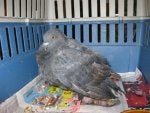Hi everyone,
I have been rescuing pigeons for the past 10 years in NYC with the help from the Wild Bird Fund in Manhattan, I have come across a pigeon with swollen joints, it was treated at first with Clyndamicyn for a week, no improvement, then someone told me it could be Salmonella so we opted for Baytril.
The swelling occurs in the knee and the wing (elbow) , have done cultures with poo samples and came out empty handed, very puzzling.
Has anyone seen or treated this condition? It appears healthy,bones seem intact in the x rays, it is eating, and has been in crate rest for the past 4 weeks, I also read about most bird diseases but they involve so many other symptoms that this bird just does not have.
Any input would be greatly appreciated.
Cesar
I have been rescuing pigeons for the past 10 years in NYC with the help from the Wild Bird Fund in Manhattan, I have come across a pigeon with swollen joints, it was treated at first with Clyndamicyn for a week, no improvement, then someone told me it could be Salmonella so we opted for Baytril.
The swelling occurs in the knee and the wing (elbow) , have done cultures with poo samples and came out empty handed, very puzzling.
Has anyone seen or treated this condition? It appears healthy,bones seem intact in the x rays, it is eating, and has been in crate rest for the past 4 weeks, I also read about most bird diseases but they involve so many other symptoms that this bird just does not have.
Any input would be greatly appreciated.
Cesar







